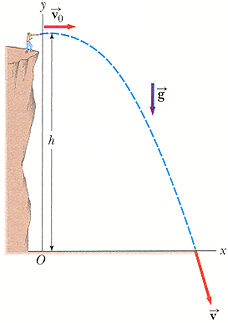A ball rolling at a constant speed falls off of a table and lands 98 cm from the bottom of the table, 0.49s after rolling off of the edge. What is the ball's velocity when it hits the ground?
1 Answer
Explanation:
The most important concept to understand here is that the vertical component of the initial velocity is equal to zero, but that the vertical component of the final velocity will not be equal to zero.
At the moment the ball leaves the table, the vertical component of its initial velocity will be equal to its initial velocity.
You thus have
#{(v_(0y) = 0), (v_(0x) = v_0) :}#
Once it leaves the table, the motion of the ball can be described using two dimensions.
Vertically, the ball is acted upon by gravity. This means that the vertical component of its initial velocity will increase under the influence of the gravitational acceleration,

Horizontally, the speed of the ball remains contant. If you take
#d = underbrace(v_(0x))_(color(blue)(=v_0)) * t -># horizontally
and
#h = underbrace(v_(0y))_(color(blue)(=0)) * t + 1/2 * g * t^2 -># vertically
These equations are equivalent to
#d = v_0 * t " "# and#" "h = 1/2 * g * t^2#
Use the first equation to find
#v_0 = d/t = (98 * 10^(-3)"m")/"0.49 s" = "2 m/s"#
Since the horizontal component of the ball's velocity remains constant, you know that
Now focus on finding
#v_(fy) = underbrace(v_(oy))_(color(blue)(=0)) + g * t#
#v_(fy) = g * t#
#v_(fy) = 9.8"m"/"s"^color(red)(cancel(color(black)(2))) * 0.49color(red)(cancel(color(black)("s"))) = "4.8 m/s"#
The final velocity of the ball will be
#v_f^2 = v_(fy)^2 + v_(fx)^2#
#v_f = sqrt(v_(fy)^2 + v_(fx)^2)#
#v_f = sqrt(("2 m/s")^2 + ("4.8 m/s")^2) = color(green)("5.2 m/s")#
If you take
#tan(theta) = v_(fy)/v_(fx) implies theta = arctan(v_(fy)/v_(fx))#
#theta = arctan((4.8color(red)(cancel(color(black)("m/s"))))/(2color(red)(cancel(color(black)("m/s"))))) = color(green)(67.4^@)#
If you need the angle above the horizontal, you have to change the direction of
#theta = arctan((-4.8color(red)(cancel(color(black)("m/s"))))/(2color(red)(cancel(color(black)("m/s"))))) = -67.4^@#
The impact velocity of the ball will thus be

